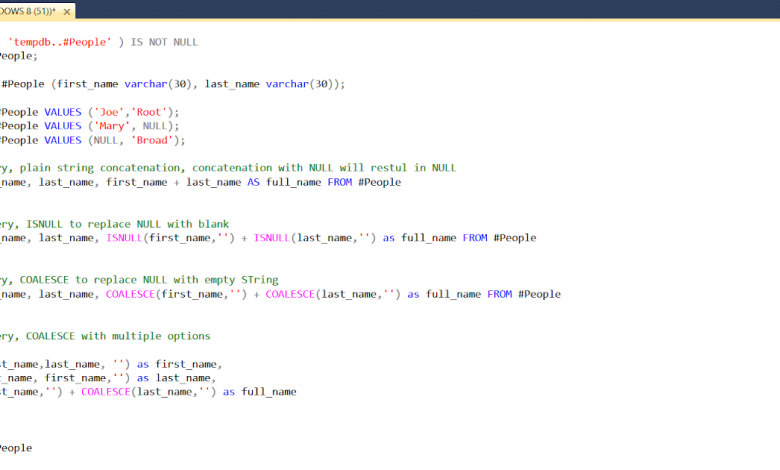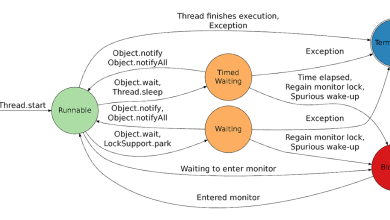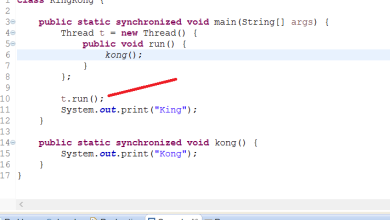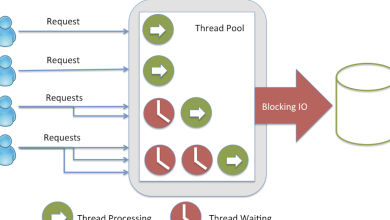How to replace NULL with Empty String in SQL Server? ISNULL() vs COALESCE() Examples

Similarly, COALESCE(column, ”) will also return blank if the column is NULL.
The only difference between them is that ISNULL() is Microsoft SQL Server-specific but COALESCE() is the standard way and supported by all major databases like MySQL, Oracle, and PostgreSQL.
Another difference between them is that you can provide multiple optional values to COALESCE() e.g. COALESCE(column, column2, ”), so if the column is null then it will use column2 and if that is also null then it will use empty String.
For SQL Server and T-SQL beginners, I also recommend Microsoft SQL for Beginners online course by Brewster Knowlton on Udemy. It”s a great course to learn T-SQL concepts, functional, and SQL Server basics.
Replacing NULL with blank in SQL SERVER – ISNULL() Example
Let’s first see, how to use ISNULL() to replace NULL String to empty String in SQL SERVER. In order to understand the problem and solution better, let’s create a sample database with some values.
IF OBJECT_ID( 'tempdb..#People' ) IS NOT NULL DROP TABLE #People; CREATE TABLE #People (first_name varchar(30), last_name varchar(30)); INSERT INTO #People VALUES ('Joe','Root'); INSERT INTO #People VALUES ('Mary', NULL); INSERT INTO #People VALUES (NULL, 'Broad'); -- cleanup -- DROP TABLE #People
Now let’s display the first name, last name and full name from #People table, where the full name is nothing but a concatenation of first and last name. Here is our SQL query:
SELECT first_name, last_name, first_name + last_name AS full_name FROM #People first_name last_name full_name Joe Root JoeRoot Mary NULL NULL NULL Broad NULL
You can see that full_name is NULL for the second and third record because for them either first_name or last_name is NULL. In order to avoid that and to replace the NULL with empty String, let’s use ISNULL() method in our SQL query:
SELECT first_name, last_name, ISNULL(first_name,'') + ISNULL(last_name,'') as full_name FROM #People first_name last_name full_name Joe Root JoeRoot Mary NULL Mary NULL Broad Broad
You can see that even though one of the joining columns is NULL but full_name is not NULL anymore because ISNULL() is replacing NULL values with a blank.
Using COALESCE() to replace NULL with empty String in SQL SERVER
In the earlier example, you have learned how to use ISNULL() to replace NULL values with blank in SQL SERVER, let’s see how can we use COALESCE() to do the same.
Remember, COALESCE() is a standard function and whenever you can use COALESCE() you should be using it.
SELECT first_name, last_name, COALESCE(first_name,'') + COALESCE(last_name,'') as full_name FROM #People first_name last_name full_name Joe Root JoeRoot Mary NULL Mary NULL Broad Broad
Let me show you another use of COALESCE() function while we are using it. You can use COALESCE() to instruct using the value of another column if the target column is NULL and if that is also null then use the third column and so on.
You can use this technique to provide sophisticated default values in your reports. For example, in this scenario, let’s display the value of last_name if first_name is NULL and the value of first_name if last_name is NULL in the report. Following SQL query uses COALESCE to do that:
SELECT COALESCE(first_name,last_name, '') as first_name, COALESCE(last_name, first_name,'') as last_name, COALESCE(first_name,'') + COALESCE(last_name,'') as full_name FROM #People first_name last_name full_name Joe Root JoeRoot Mary Mary Mary Broad Broad Broad
Here is the screenshot of SQL queries from Microsoft SQL SERVER 2014 database to give you full view:
That’s all about how to replace NULL with empty String or blank in SQL SERVER. You can use ISNULL() or COALESCE() to replace NULL with blanks. It’s particularly important to use these functions while concatenating String in SQL Server because one NULL can turn all information into NULL.
Btw, you can also use CONCAT() instead of + operator to avoid NULL, this function returns the value of nonnull argument if another argument is NULL. Between ISNULL() and COALESCE(), use ISNULL() if you know for sure that your code will run on Microsoft SQL Server but COALESCE() is better because it’s standard and you can use it to replace NULL with empty String in any database like Oracle, MySQL, and PostgreSQL.
Further Learning
Introduction to SQL
The Complete SQL Bootcamp
SQL for Newbs: Data Analysis for Beginners



